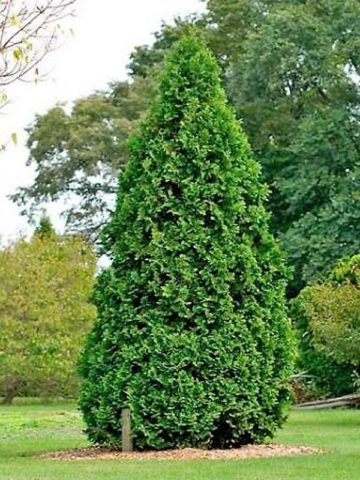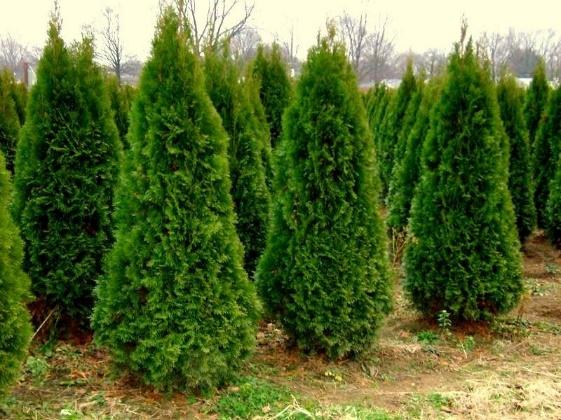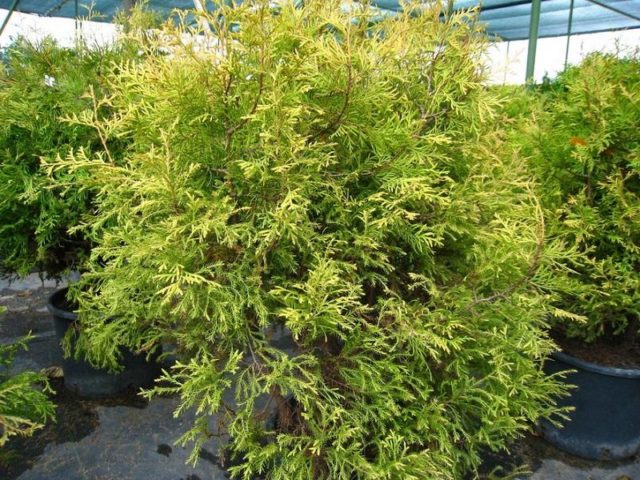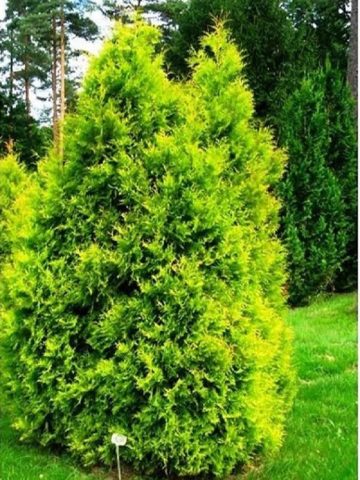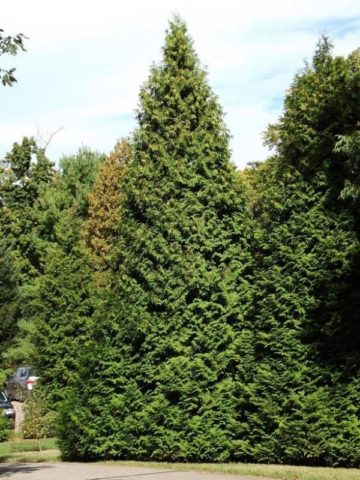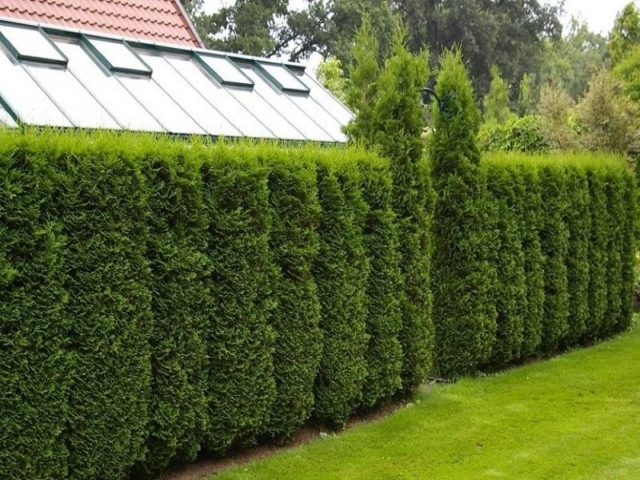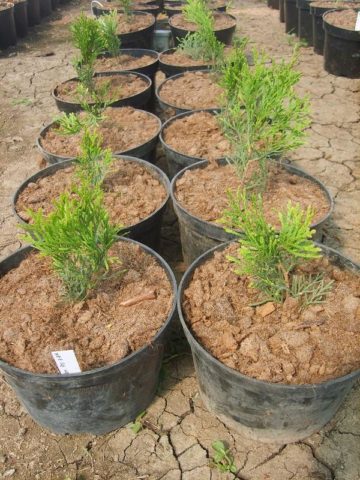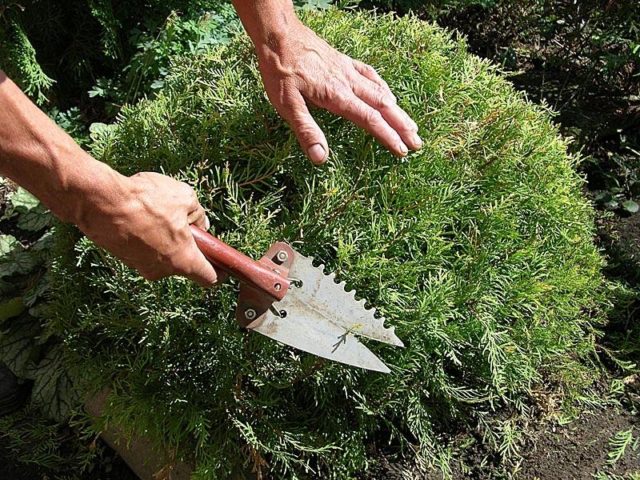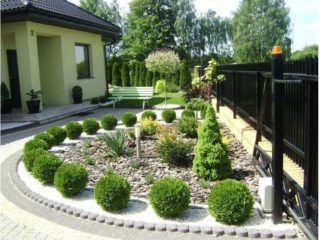Content
The pyramidal thuja is most often found in squares and parks as hedges and tapeworms. Its value lies not only in the unpretentiousness and unpretentiousness of the plant, but also in the ability to maintain a beautiful clear shape even without a haircut.
The ancestors of the pyramidal thuja originate in North America, where in natural conditions they reached 30 m in height.
Description of the pyramidal thuja
Western pyramidal thuja has a brown or red bark; in mature trees, it sometimes begins to flake off with ribbons. Wood contains essential oils used in medicine.
Crohn with age can change its shape from pyramidal to columnar. Thuja needles are dark green in summer and brown in winter. Fits snugly to the shoots. At a young age, it is soft, later it coarsens, becomes scaly. The needles are changed every three years. Thuja cones are brown, small, each with two seeds.
Thuja pyramidal lives for about 100 years and loses its lower branches by old age, becoming less decorative.
The tree grows slowly. It belongs to shade-tolerant plants, undemanding to the soil, but on fertile loams its appearance is much better than on poor soils. Pyramidal thuja is winter-hardy, tolerates wind and frost well to the latitude of the Leningrad region in the west and Yekaterinburg in the east. Suffers from heavy snow that can break its branches and main trunk.
Varieties and varieties of pyramidal thuja
A variety of western thuja - pyramidal or cone-shaped, unites many varieties that are distinguished by extraordinary decorativeness. The most popular among them are often used in landscaping.
Thuja Douglas
The variety was bred at the beginning of the last century in the United States and quickly spread throughout Europe. Douglas' pyramidal western thuja is shade-tolerant and frost-hardy. The needles are dark green, flat. The branches are short, thin, rising up, like a fern. The lower ones gradually dry up and fall off.
Douglas' pyramidal thuja grows slowly, the maximum height is 15 m, suitable for group and single plantings.
Emerald
This is the most popular variety of cone-shaped thuja, with emerald needles that do not tarnish when shaded. The tree looks like a cypress. Has a narrow, dense, pyramidal crown.
Annual growth is 10 - 20 cm in height. The branches are arranged vertically. Plant cones are brown, small, oval, 1 cm long. Pyramidal thuja is resistant to unfavorable climatic conditions and environmental pollution. The application is universal.
Vervain
The western pyramidal thuja variety was bred in the middle of the 19th century in Belgium. The tree changes the color of the needles depending on the season. In summer it is light green or yellow, in winter it is brown. The crown of the plant is dense, in the form of a narrow cone. In adulthood, thuja reaches 15 m in height.
The branches are numerous, thin and soft. Most often, trees are used to create alleys near houses, in squares and parks.
Riversie
Western pyramidal thuja Riversi is a tree 5 m high. It has a compact, wide-conical crown. Shoots are short, inverted. The needles change their color.
In winter, it is yellowish-green, in summer it is yellow.Thuja is winter-hardy. The plant is used to create hedges and single plantings. It prefers to be located in areas fully illuminated, in the shade it loses its golden color of needles.
Ellvangeriana
Low thuja (2.5 m) with a wide-conical crown. Shoots are straight, branched at the ends. On young branches, the needles are needle-like, soft, in an adult state - scaly, pressed.
In winter it has a grayish tint. The variety is winter-hardy. The pyramidal thuja of Ellvangeriana is propagated by cuttings and seeds. Looks gracefully in the foreground of plantings as a single plant.
The most graceful
The variety belongs to the western pyramidal thujas (photo).
Trees reach a height of 5 m, their crown is dense, broadly conical. The needles are shiny, bright. At the ends of the shoots there are white marks. The plant is highly winter-hardy. Reproduction is carried out by cuttings and seeds. The second method does not give full inheritance of varietal traits. The use of thuja pyramidal is universal.
Application in landscape design
Many varieties of pyramidal thuja are ideal for creating hedges as they are tall and neat in shape. "Living walls" are able to protect the site from wind, dust, prying eyes. For this purpose, they are planted in the background, letting flowering shrubs and perennials forward. With the help of a small pyramidal thuja with delicate emerald needles, you can decorate flower beds or create a stylish composition of several plants located on the lawn. An original haircut will make it unique.
Breeding features
Thuja pyramidal grows slowly, especially at first, so the seed propagation method is not often used. Its disadvantage is the loss of varietal properties by new plants.
If you decide to use the method, you should take into account the recommendations:
- large seeds must be selected that have lain under the snow all winter;
- fill the container with nutritious soil;
- spread the seeds over the surface and cover them with soil with a layer of 2 cm;
- after the emergence of seedlings, the care is standard - watering, shading, feeding.
Seedlings of pyramidal thuja, obtained by the seed method, are ready for planting in a permanent place only after 5 years.
The most popular method of propagation by cuttings. With this method, the seedlings retain all the characteristics of the mother plant. There are several things to do:
- prepare cuttings of pyramidal thuja in early spring;
- disinfect and treat them with a root stimulant;
- prepare a container with a drainage layer and soil for conifers;
- place the cutting in the soil and place the container in a dark place with an air temperature of up to 20 ⁰C;
- After the appearance of growth, move to the greenhouse;
- a sapling of a pyramidal thuja is transferred to a permanent place after 2 years.
Landing rules
In order for the pyramidal thuja not to get sick, to give good gains, several rules must be observed:
- purchasing a healthy seedling;
- choice for planting a place that meets the requirements of the plant;
- strict adherence to deadlines;
- digging a hole in advance, corresponding to the size of the thuja root system;
- drainage preparation;
- planting a tree according to the algorithm.
Recommended timing
Young pyramidal thuja with a closed root system can be planted in the ground during the entire growing season. But plants take root best of all in early spring or autumn. The ideal time for this is the end of March, when the soil and air have warmed up, or the beginning of September.
The early spring planting of the pyramidal thuja allows it to take root before the onset of the summer heat. After the fall, the plant has time to prepare for the winter cold, to strengthen the root system.
Planting pyramidal thujas is recommended in the early morning or late evening on a cloudy day. In hot sunny weather, the seedling should be shaded with paper, burlap.
Site selection and soil preparation
The full value of the growth and development of the pyramidal thuja depends on the correct choice of location and preparation of the soil for it.
You should not choose an area where the sun will be present all day. Its incinerating rays can make the color of the needles less vivid. Penumbra is quite suitable for planting a plant. The place must be protected from winds and drafts. At the same time, thuja easily tolerate polluted, gassed air.
It is worth observing the distance to other thujas, tall deciduous and coniferous trees, which should not shade and drown out the seedlings.
The pyramidal thuja is unpretentious to soils, but it grows better on air-permeable loams. High groundwater location, waterlogging does not tolerate. She likes sod land mixed with sand and peat.
Landing algorithm
After choosing a seedling and determining its location, you can start planting pyramidal thuja. This requires:
- Soak the root system of the seedling.
- The hole for the thuja should be made 40 cm wider than the earthen coma and 30 cm deeper.
- The distance between them is from 0.5 m to 5 m, depending on the expected stocking density.
- As a soil mixture, you can use ordinary turf soil with the addition of compost and wood ash.
- Make drainage from expanded clay or broken brick at the bottom of the pit.
- Pour the soil mixture in a slide.
- Place the seedling in the center and fill it up so that the root collar is above the surface of the soil.
- Compact the earth around the thuja.
- Water abundantly.
- Mulch the trunk circle.
Growing and care rules
After planting, the pyramidal thuja requires the usual uncomplicated care. At first, regular watering is needed so that the seedling takes root and begins to grow. The plant does not need frequent feeding, but the use of mineral and organic fertilizers has a positive effect on its condition. Pruning is carried out as needed. The fight against diseases and pests is carried out for prophylactic purposes and for the treatment of an already diseased tree, the destruction of insect pests.
Watering schedule
Young pyramidal thuja requires regular watering. Ten liters a week is enough for one tree. In very hot weather, the rate and frequency of watering should be doubled.
If the seedling is large, then it is moistened like an adult plant - 50 liters under one tree.
Care must be taken not to wash out the soil from the root area. The best time to water is early morning or late evening. Thuja pyramidal responds well to sprinkling. Dust and dirt are washed off from its crown, the air is filled with phytoncides, a pleasant coniferous aroma.
Top dressing
Thuja pyramidal is undemanding to the soil and its fertility, it can grow successfully without top dressing. Additional nutrition of the plant leads to a response from its side in the form of accelerated growth, improving the quality of needles.
Most often, when planting a seedling, organic matter or mineral additives are introduced into the pit. The next top dressing should be done no earlier than two years later.
For adult pyramidal thujas, it is enough to apply complex fertilizers for conifers once - in spring or summer.
Pruning
The feasibility of pruning depends on the decorative purpose of the plant. The intensity of the haircut is different for each variety.
By their nature, pyramidal thuja are geometrically correct, their shape can be left uncorrected. To maintain it in a certain state, annual shoots are removed. The first shaping haircut is carried out no earlier than two years after planting. It is required by the hedgerows for a more defined shape.
Obligatory annual pruning of the pyramidal thuja for sanitary purposes to remove damaged and diseased shoots. The time is spring, before bud break.Thuja tolerates this procedure well and reacts with the rapid growth of green mass. Plants are trimmed with a sharp garden shears or scissors that cannot injure the shoots.
Preparing for winter
Adult and strong pyramidal thuja successfully winter without additional shelter, especially if planted next to a house or tall deciduous and coniferous trees. A young plant needs protection in winter, when the temperature drops below -35⁰С. A covering non-woven material or burlap is used to protect the crown, the trunk must be covered with earth and the trunk circle must be mulched.
Experts advise covering the pyramidal thuja with spruce branches, spandbond or special covers that can be purchased in the store in the first five years after planting. In a snowy winter, you should clear the branches of the thuja from snow or tie the crown with twine in advance so that the shoots and trunk of the plant are not damaged under its weight.
Pests and diseases
In order for the pyramidal thuja to please with its appearance, beauty and grandeur, it is necessary to protect it from diseases transmitted from other plants:
- late blight - the root and crown are affected, the thuja changes color and withers, a white bloom appears on the trunk;
- brown shoots - scales turn yellow, shoots turn brown and die;
- rust shute - the needles of young plants darken and fall off.
For treatment and prevention, folk remedies, fungicides and other chemicals are used.
The main pests of thuja include:
- thuja aphid;
- speckled moth;
- false shield;
- click beetle;
- wireworm.
Plants should be constantly examined and at the first signs of pests, they should be treated with insecticides.
Conclusion
Pyramidal thuja has long been successfully used in the design of plots because of its attractiveness, undemanding soil, unpretentious care. With its help, you can create hedges, beautiful compositions in combination with ornamental shrubs and flowers. Growing thuja is not difficult even for a novice amateur gardener.
Testimonials

